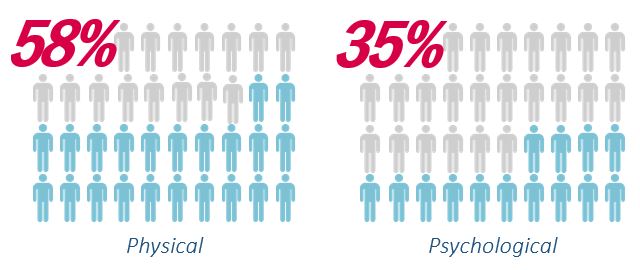Two-thirds of psychological claimants report no workplace contact

Analysis of the National Return to Work Survey 2013 and 2014 confirms that psychological injury claims continue to lag behind physical injury claims in terms of speed, success and durability of return to work.
The same research shows that workers claiming for psychological injury are treated differently by their employers than those claiming for physical injury.
One of the key differences concerns the amount of time it takes the workplace to get in touch with the worker after a claim is lodged. In fact, nearly two-thirds (65%) of workers with a psychological claim say that they were never contacted about their injury. By comparison, around two-fifths (42%) of physical claimants were not contacted by the workplace.
The graphic below illustrates these figures, comparing the number of physical claimants who say they were contacted by the workplace with the number of psychological claimants who reported contact.
Of the psychological claimants surveyed:
- 18% were contacted within 3 days;
- 7% were contacted within 4-10 days;
- 2% were contacted within 11-15 days;
- 8% were contacted within 16 days or more; and
- 65% were never contacted.
It is difficult to overstate the size of the missed opportunity that these statistics detail. For psychological claims, the improvements associated with early contact are huge. The data shows that 80% of workers contacted within three days of lodging a claim for psychological injury had returned to work. This figure dropped to 62% for workers contacted 16 or more days after their claim was lodged, and fell again to 49% for workers who said that they employer did not contact them at all.
We can’t say for sure that early contact causes these improvements; at this stage the research only shows an association between early contact and better outcomes. However, to put the figures in perspective, when contact occurs within three days of the claim workers are 63% more likely to return to work than when no contact occurs at all.
To gain insight into why this might be, let’s imagine what the lack of contact might feel like from the perspective of a worker – for example, a man suffering from anxiety that he believes is work-related. After months of simply coping with the symptoms and coming to work, he’s finally taken some time off and has submitted a workers’ compensation claim.
Bear in mind that he, like 75% of people who submit a psychological injury claim, is worried that he’ll be treated differently in the workplace. Like more than half (59%) of psychological claimants, he doesn’t think his supervisor takes his injury seriously enough. (We'll share more information about these statistics soon, and link to the details once they're online.)
Add this to the fact that he is grappling with the symptoms of clinically diagnosable anxiety, which can include a racing heart, dizziness, and persistent worried thoughts. (In 2007, psychologists who investigated 400 psychological injury claims found that, regardless of whether the injury was later determined to be work-related, in 85% of cases the person making the complaint had symptoms severe enough to be diagnosed with a clinical disorder.)
Now that the claim has been lodged, he has something new to worry about: whether anyone will believe him, and whether he’ll still be welcome in the workplace once he recovers. A day stretches into a week, one week into two, and still he hasn’t heard from his supervisor, the RTW coordinator, the HR department. He becomes convinced that he’s going to be fired. Without his income, his family will likely lose their house. He can’t sleep for worrying. He feels powerless to change his situation. He doesn't know where to turn for support. During the day he’s so jittery that he can’t imagine ever returning to work.
Psychological claims are complex but here is a simple truth: return to work outcomes are better when workers say that their employer got in touch with them soon after a claim is lodged.
For practical advice on calling psychological claimants, and for suggestions on how to ensure that early contact is a priority in your workplace, see our companion article here.


